|
|
|
Sort Order |
|
|
|
Items / Page
|
|
|
|
|
|
|
| Srl | Item |
| 1 |
ID:
121533
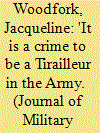

|
|
|
|
|
| Publication |
2013.
|
| Summary/Abstract |
Uniquely among European colonies, some indigenous inhabitants of the French West African colony of Senegal were made citizens of the metropole in the nineteenth century. This originaire status, as it was known, allowed them to, among other things, elect a member of the French parliament in Paris. But, the civil status of the colonial population of Senegal also influenced how its members who served in France's West African colonial army, the Tirailleurs sénégalais, were fed, clothed, housed, and paid. Using oral and archival sources, this article looks at how this cleavage between citizens and subjects influenced the relationship of Senegalese soldiers to the colonial state, the military, their officers, and each other.
|
|
|
|
|
|
|
|
|
|
|
|
|
|
|
|
| 2 |
ID:
121535
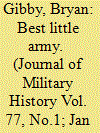

|
|
|
|
|
| Publication |
2013.
|
| Summary/Abstract |
Historians have generally assumed that the poor showing made by the South Korean military in the opening stages of the Korean War was inevitable and have attributed much of the blame for this to the U.S. Army advisory group in Korea, known colloquially as "KMAG." However, a closer look at the documentary evidence shows that KMAG was keenly aware of the South Korean military's shortcomings and was doing its best to correct them as war came. Although KMAG's program to improve the equipment and leadership of the South Korean military and to focus its efforts on conventional defense, as opposed to counterinsurgency activities, proved insufficient to stop the North Korean invasion, U.S. advisors did succeed in forging an infrastructure that allowed the South Korean army to survive and eventually to grow into a potent military force during the war.
|
|
|
|
|
|
|
|
|
|
|
|
|
|
|
|
| 3 |
ID:
121534
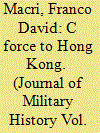

|
|
|
|
|
| Publication |
2013.
|
| Summary/Abstract |
In November 1941 two Canadian infantry battalions arrived in the British Crown Colony of Hong Kong as reinforcements for the garrison. This deployment is considered an element of Britain's effort to deter Japanese aggression south against areas more vital, but this paper will demonstrate how other significant geopolitical issues led to this event. Canadian troops were sent to Hong Kong largely because of U.S. influence. Aimed at bolstering Chinese morale, Hong Kong's reinforcement was meant to sustain the Sino-Japanese war in order to provide indirect support to the Soviet Far East when the Red Army faced destruction in Europe.
|
|
|
|
|
|
|
|
|
|
|
|
|
|
|
|
| 4 |
ID:
121537
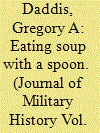

|
|
|
|
|
| Publication |
2013.
|
| Summary/Abstract |
Standard Vietnam War narratives often argue that the U.S. Army lost the war because it failed to learn and adapt to the conditions of an unconventional conflict. Based on a reappraisal of learning processes rather than on the outcome of the war, this essay argues that as an organization, the U.S. Army did learn and adapt in Vietnam; however, that learning was not sufficient, in itself, to preserve a South Vietnam in the throes of a powerful nationalist upheaval. A reexamination of the Army's strategic approach, operational experiences, and organizational changes reveals that significant learning did occur during the Vietnam War despite the conflict's final result.
|
|
|
|
|
|
|
|
|
|
|
|
|
|
|
|
| 5 |
ID:
121532
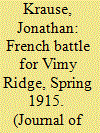

|
|
|
|
|
| Publication |
2013.
|
| Summary/Abstract |
The unprecedented scale of trench warfare in the First World War posed a series of challenges to attacking forces. This article tracks the early French steps to develop a coherent doctrine for launching offensives against established trench systems, focusing on a specific battle in May-June 1915: Second Artois. This battle would be the first based on lessons learned and digested by the French army after its initial tentative efforts at trench warfare from December 1914 to March 1915. As such it provides an interesting starting point for an analysis of the French army's development of trench tactics in the First World War and of the part this played in the general effort made by the two sides to find ways to break the post-1914 stalemate on the Western Front.
|
|
|
|
|
|
|
|
|
|
|
|
|
|
|
|
| 6 |
ID:
121531


|
|
|
|
|
| Publication |
2013.
|
| Summary/Abstract |
Admiral William Halsey gained both fame and scorn for his direction of fleet forces in World War II. Most historians have attributed his command performance to personality traits; Halsey was aggressive, bold, and impetuous. But his command of naval forces in World War II was as much the product of nearly four decades in uniform as it was any innate trait. From 1914 to 1922, Halsey learned much about naval warfare and fighting from his service with destroyers, which took place largely under the direction of Admiral William Sims, one of the Navy's greatest reformers.
|
|
|
|
|
|
|
|
|
|
|
|
|
|
|
|
| 7 |
ID:
121536


|
|
|
|
|
| Publication |
2013.
|
| Summary/Abstract |
It has often been claimed that British prisoners behaved better than American prisoners during the Korean War (1950-1953). This assertion has tended to be the result of speculative assumption rather than detailed analysis, however, and does not hold up well when examined closely. As a very broad generalization, furthermore, it masks significant variations in the conduct of British prisoners of war themselves. The primary aim of this article is to test various hypotheses to explain why, from the Chinese perspective, the captive British contingent at Chongson (Camp 1) was much more troublesome than its counterpart at Pyoktong (Camp 5).
|
|
|
|
|
|
|
|
|
|
|
|
|
|
|
|
| 8 |
ID:
121530


|
|
|
|
|
| Publication |
2013.
|
| Summary/Abstract |
The Imperial Cadet Corps (ICC), was founded in 1901 by the British Raj to give officer training to the princes and gentlemen of India. This article situates the ICC at the intersection of the history of war and society, and colonial Indian history, and contextualizes it within the debate on the Indianization of the Indian Army's officer corps. Though the ICC failed, and closed in 1917, this article argues that it nevertheless established the precedent for the officer training of Indians in India, which reached full fruition when the Indian Military Academy opened in 1932.
|
|
|
|
|
|
|
|
|
|
|
|
|
|
|
|
| 9 |
ID:
121529


|
|
|
|
|
| Publication |
2013.
|
| Summary/Abstract |
During the American War of Independence, the revolutionaries captured thousands of British and German soldiers. Focusing on common German soldiers, this case study explains the various ways in which American revolutionaries turned these prisoners of war into useful enemies for their war effort. To boost morale, revolutionaries staged elaborate rituals with prisoners of war. Congress, the states, and local citizens hired captive soldiers as prisoner-laborers. After the victory at Yorktown in 1781, Congress and the Continental Army recruited German prisoners of war, allowed them to go free after cash payments, and even sold them into indentured servitude to save expenses.
|
|
|
|
|
|
|
|
|
|
|
|
|
|
|
|
|
|
|
|
|